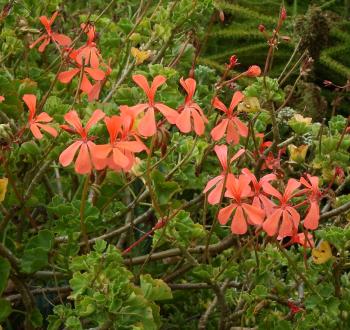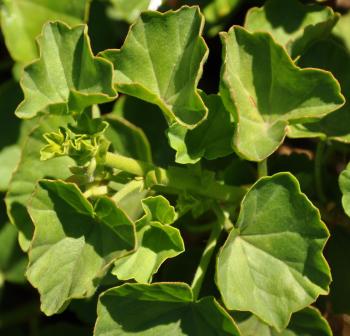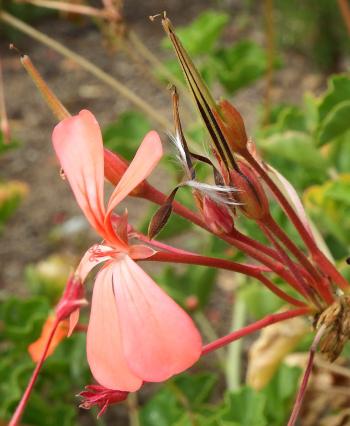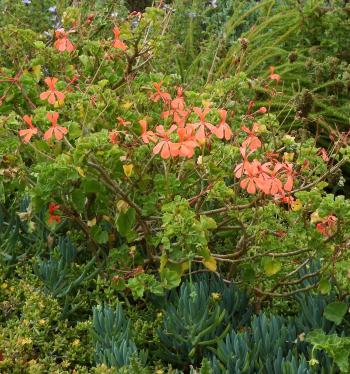Pelargonium salmoneum
Pelargonium salmoneum R.A.Dyer
Family: Geraniaceae
Common names: salmon pelargonium
Introduction
This amazing succulent, garden plant, sizzles from a sunny corner for most of the year with its salmon-pink flowers cheering up borders, pots, tubs, rockeries, with very little water required.

Description
Description
Pelargonium salmoneum is a bushy, evergreen shrublet of 400–800 mm tall. The terete branches are 4–5 mm thick. Initially very soft when young, but hardening as it ages. The leaves are yellowish green, with 15–40 mm long petioles, and broadly ovate to ovate-lanceolate stipules, 5–13 mm long and 4–7 mm broad.

The flowers are borne in flowerheads of 4–20 flowers, each with a pedicel of 28–30 mm long atop a peduncle that varies from 40 to 200 mm long. The sepals are lanceolate to oblong-lanceolate and 10–12 mm long. The petals are salmon-pink, the upper 2, or all of them, are often red-veined. The ovary is densely villous. Fruits are 40–4 mm long, with prominent, spreading, white or light grey hairs on the beak.

The flowering peak is from early winter to early summer. During midsummer flowering comes to a complete halt and only resumes again in late autumn.
Conservation Status
Status
According to the Red List of South African plants, checked on 16 October 2017, the conservation status of this species is Data Deficient – Taxonomically Problematic (DDT).
Distribution and habitat
Distribution description
The native habitat of this species is currently still unlocated. Earlier suggestions has its origin as the area of the Van Stadens River, in the vicinity of Port Elizabeth, in the Eastern Cape.
Derivation of name and historical aspects
History
The name Pelargonium is derived from the Greek word pelargos, meaning ‘stork’ because the rostrum of the schizocarp in Pelargonium is thought to resemble the bill of a stork. This explains the common name, stork’s bill. The specific epithet salmoneum is in reference to the salmon-pink petals the species exhibits.
Pelargonium salmoneum was initially treated as an ornamental in the Port Elizabeth municipal garden. This description featured in the Kew Bulletin publication of 1932. Curtis’s Botanical Magazine published a more comprehensive description, accompanied by a colour illustration, in 1934.
Pelargonium salmoneum is related to P. zonale (L.) L.’Her., P. inquinans (L.) L.’Her. and P. acetosum (L.) L.’Her. An unnamed specimen (No 1294) at the National Herbarium in Pretoria, which was collected among rocks near Komgha by H.G. Flanagan in 1892, is the closest possible clue from where this species could have originated from. However, despite this particular specimen being closer related to P. salmoneum than any of the trio of P. zonale, P. inquinans and P. acetosum, the absence of field knowledge makes it impossible to assess for critical aspects, such as minor differences concerning the shape of the calyx or stem thickness.
The pelargonium family or Geraniaceae consists of 5 genera, of which the genus Pelargonium is one. The genus consists of approximately 250 species in southern Africa. Geraniaceae is a cosmopolitan family confined to temperate and tropical regions such as S, E and NE Africa, Australia, New Zealand, St Helena, Tristan da Cunha, Madagascar and Asia. Southern Africa, which is home to more than 80% of the species, is regarded as the global hotspot of Pelargonium. The highest diversity amongst members of this family is found in the Namaqualand region, and the western and southern Cape of South Africa.

Ecology
Ecology
The specific pollinator of Pelargonium salmoneum is not known. Butterflies and various types of bees, including carpenter bees, honey bees and bumble bees, are some of the insects that can be associated with pelargonium pollination.
In this genus, all seeds have a feathered, tail-like structure, which is coiled in a spiral arrangement. The tail enables the light seed to twist around in the wind and drills itself into the soil. This smooth action provides more seed with realistic opportunity to germinate successfully.
Uses
Use
No uses for medicinal purposes have been recorded.
Pelargonium salmoneum has very economical water requirements and can be successfully used in tubs, pots or rockeries. Use it further for mass plantings, as a border or filler plant and for mixed interplantings.

Growing Pelargonium salmoneum
Grow
This species is generally propagated through the making of cuttings right through the year. Stem cuttings larger than 70 mm, can be cut below the node and treated with a rooting hormone. Place the cutting in prepared holes, which are just slightly bigger than the cutting stem, in a sterilized and well-draining, rooting medium, like coarse river sand. Transfer the cutting cuttings to a cold frame or an area with some shade. Roots normally develop within 3 to 4 weeks.
Sow seed in late summer or early autumn in a well-draining medium, use either compost or fine river sand, to cover the seed. Water seed gently with a very fine spray and take great care in ensuring that the medium does not get overwatered, but just stays moist.
Companion plants may include: Aloe pluridens, A. ferox, A. aborescens and A. speciosa, Pelargonium acetosum, P. reniforme, P. inquinans and P. ionidiflorum, Strelitzia reginae and S. juncea, Portulacaria afra, Tylecodon paniculatus, Cotyledon orbiculata, Curio crassulifolius and C. ficoides, Dovyalis caffra, Cussonia spicata and C. paniculata and Celtis africana.
Feed adult plants with 3:1:5, once in autumn, and supplement it with seaweed-based, liquid fertilizer application every 2 weeks during the growing season. Seedlings and rooted cuttings can also be treated with a liquid seaweed-based fertilizer.
Plants tend to become lanky after a while, and a good prune at least every second year will ensure plants maintain a nice full and bushy appearance. Cut it back by at least a third to half its size in late summer to early autumn. Where conditions allow for it, this species may become overgrown and actually starts scrambling over other species that are capable of withstanding its weight.
Plants will tolerate poor soil, but for an optimum performance opt for rich soil. At Kirstenbosch National Botanical Garden it performs equally well in compacted and well-drained soil.
No pest and diseases have been recorded.
References
- Dyer, R.A. (ed). 1945–1946. Pelargonium salmoneum. The Flowering Plants of Africa. Vol XXV. J.L. van Schaik, Pretoria.
- Eliovson, S. 1973. South African wild flowers for the garden. Macmillan, Johannesburg.
- Oliver, R. 2017-10. Pelargonium sericifolium J.J.A van der Walt (Geraniaceae). PlantZAfrica. Internet 6 pp. http://pza.sanbi.org/pelargonium-sericifolium
- Stearn, W. 2002. Stearn's dictionary of plant names for gardeners. Timber Press, Portland, Oregon.
- Van der Walt, J J A. 1977. Pelargoniums of South Africa. Purnell, Cape Town.
Credits
Roger Oliver
Kirstenbosch National Botanical Garden
October 2017
Plant Attributes:
Plant Type: Shrub, Succulent
SA Distribution: Eastern Cape
Soil type: Sandy, Loam
Flowering season: Spring, Early Summer, Autumn, Winter
PH: Acid, Neutral
Flower colour: Pink
Aspect: Full Sun
Gardening skill: Easy
Special Features:
Horticultural zones











Rate this article
Article well written and informative
Rate this plant
Is this an interesting plant?
Login to add your Comment
Back to topNot registered yet? Click here to register.